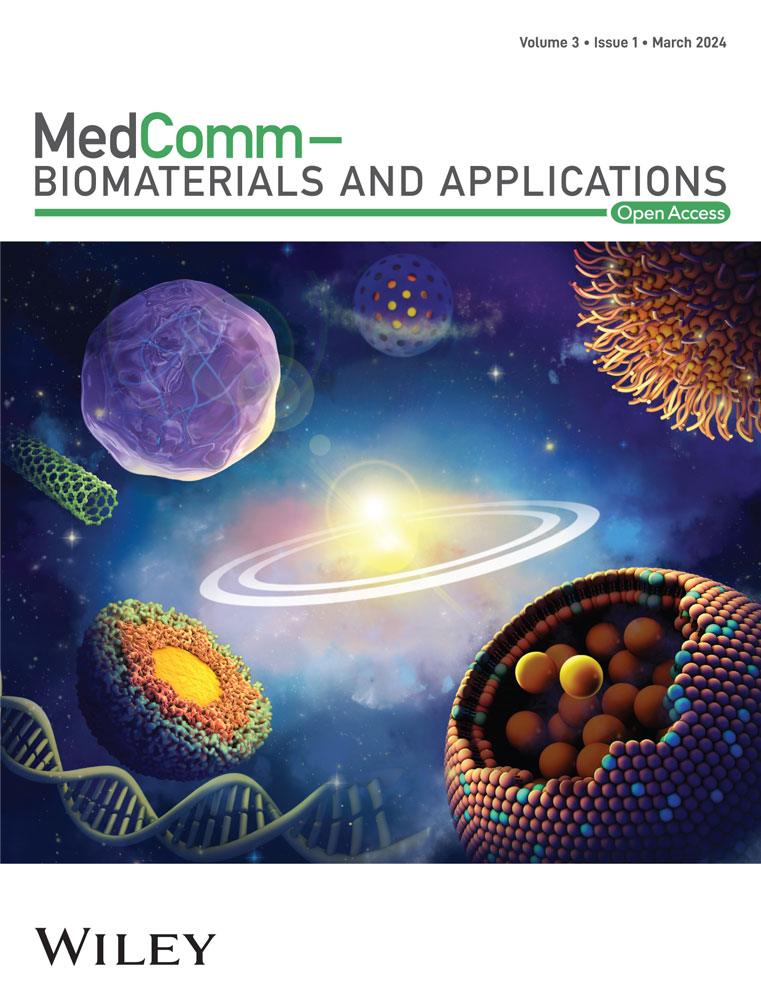Spatiotemporal omics of life energy: Towards medicine of frequencies and terahertz drugs
Li-Ping Wang, Feng Gao, and Zhou-Xiang Zhao contribute equally.
Abstract
The quantum mechanisms how life efficiently utilizes energy and transmits information remain unclear yet. Frequency medicine, an emerging cross-discipline of both quantum mechanics and biomedicine, is a promising turning point for biomaterials and medicine developing from the matter level to the energy level. Recognizing the pivotal role of molecular vibrational frequencies in resonant energy coupling and transmission underscores the potential of frequency medicine to precisely regulate biomaterial vibrations, influencing interactions and reactions in living organisms. At present, scientists have unveiled sophisticated phototherapeutics; nevertheless, their advancement necessitates the precise mapping of the life energy. In contrast to genomics, proteomics, and metabolomics studied on the matter level, omics of frequencies related to medicine should be on the energy level. Herein, starting from the history of frequency medicine, and followed by the introduction of vibrational strong coupling applications in life sciences, we emphasize the significance, necessity, and urgency of studying spatiotemporal omics of medicine frequencies. By decoding the energy atlas of life, we can acquire profound insights into the quantum mechanisms that govern life processes from an energy standpoint. We anticipate that the integration of biomaterials with spatiotemporal frequency omics related to medical research will contribute significantly to advancing the goals of precision medicine, potentially revolutionizing pharmaceuticals, such as terahertz drugs.
1 HISTORY OF FREQUENCY MEDICINE
In physics, frequency is the number counting the periodic event (e.g., oscillations, waves) per unit of time and is measured in hertz (Hz). Frequency medicine is based on the resonance theory and employs electromagnetic or mechanical waves of specific frequencies to diagnose or treat health problems, for example, phototherapy, magnetotherapy, and acoustic therapy. These illness treatments have been used by humans for a long time but the exact frequency was unknown at that time, and most probably was ascribed to the lack of detection instruments. For example, ancient Chinese medicine used the so-called five-color diagnosis based on the different color variations of green, red, yellow, white, and black shown by the patient's body.1 According to Hippocrates, the ancient Greek father of medicine, “the best doctor on earth is the sun.” The famous Chinese medical ancient book “Huang Di Nei Jing” also disclose the importance of sun to human health.2 A new chapter in modern phototherapy has been opened since the 17th century, when Newton utilized a prism to split white light into beams of various colors. Later, Finsen successfully cured smallpox lesions and lupus-related skin infections using red light and violet light, respectively. After Einstein proposed the laser theory in 1916, Dr. Mester first found the anti-inflammatory and analgesic effects of laser, which opened the commencement of widespread application and research of laser therapy.3, 4 The “Precious Essential Formulary for Emergency” written by Simiao Sun in Tang Dynasty records that powdered magnets can be used to treat gold sores. As to acoustic therapy, humans have long realized that music can cure diseases. In addition, the “Huang Di Nei Jing” also described the theory of “five tones for disease treatment.” The therapeutic effects of music were first systematically described in Musical Medicine by the physician Brow in the early 19th century. Recently, ultrasonography has become an important means of nondestructive medical testing and diagnosis.5 In terms of thermotherapy, ancient humans have long recognized the therapeutic effects of heat on diseases. An ancient Chinese medicine recorded that moxibustion with garlic can be used to cure tumors. Additionally, Hippocrates also said, “If there were a way to heat bones, then all diseases can be treated.” In recent years, photothermal therapy has emerged as an effective means for treating tumors.6, 7 According to quantum theory, matter is composed of rotating particles with different vibrational frequencies and its essence is energy. The human body can be considered as a frequency assemblage or energy atlas. Thus, Albert Einstein predicted that future medicine will be the medicine of frequencies.
2 FREQUENCY-BASED THERAPEUTIC METHODS
Many natural substances, artifacts, and traditional remedies that are closely related to frequency already existing in life, which benefit people's physical health in daily life. The sun provides energy to life on the Earth by radiating photons with different frequencies, for example, ultraviolet (UV), visible, and infrared (IR) light. Moderate exposure to these light sources and the absorption of light energy appear to be beneficial to human health. Epidemiological data suggests that irradiation with low-frequency, low-energy red, and near-IR light can have positive effects on the prevention and treatment of chronic diseases such as diabetes and cardiovascular disease.8
Natural minerals are commonly regarded as substances with specific energies that contribute to improve both the mood and health of people. For example, Zaytsev et al.9 successfully prepared multichannel sapphire crystals for efficient and low-energy terahertz wave conduction. Magnetotherapy is another method to treat diseases by applying a magnetic field to the specific part of human bodies. It has been reported that electromagnetic fields can be used to treat various cardiovascular diseases, including heart failure, arrhythmias, and hypertension, and there may be potential immunomodulatory therapeutic effects of extremely low-frequency electromagnetic field stimulation.10, 11
Sound is a wave produced by the vibration of an object and essentially carries energy as well. In serving as the medium for daily human communication, language is influenced by the fundamental vowels and variations in vocal tract size, both of which impact the frequency of sound. When linking language with frequency medicine, it is also important to consider the effects of word order and tonal variations on therapeutic efficacy. Research results have shown that hypnosis is effective in the treatment of communication disorders and acquired neurological diseases.12 Music with different frequencies can also stimulate appetite by affecting the secretion of hypothalamic neuropeptide Y and ghrelin.13 Healing with Himalaya bowls is done by tapping or rubbing the alms bowl to produce sounds to induce a sense of calm and relaxation, and it could be related to the ability of the frequency of the bowl sound to synchronize and activate brain waves.14, 15
Moxibustion therapy is based on the use of moxa leaves as raw materials, burned at body surface points or painful areas, dredging the human meridians to improve “qi” (could be understood as energy flow) and blood deficiencies, and enhance immunity. The mechanism of moxibustion therapy includes heat, medicinal penetration, and good absorption of near- and mid-infrared (MIR) light to the human body during combustion, which promotes localized skin metabolism.16, 17 In addition to thermal conduction, common household electric blankets can produce low-frequency IR radiation, which is closely associated with the absorption and exchange of human body energy, particularly playing a crucial role in maintaining thermal balance and regulating energy exchange. However, some studies have indicated that the use of electric blankets may increase the risk of developing breast cancer.18
3 RESONANT ENERGY COUPLING AND TRANSFER
Different molecules, due to their unique chemical structures, exhibit different spectroscopic properties, for example, absorption, scattering, and emission, or conduction of energy at specific frequencies, thus triggering biochemical and physiological reactions in living organisms.19 Resonant energy coupling and transmission are crucial mechanisms in biological systems. In photosynthesis, resonant coupling plays a vital role by efficiently capturing and converting light energy, serving as a key step in the biochemical reaction chain. Beyond its role in photosynthesis, resonant coupling also plays a significant role in various biological processes, including cellular metabolism and molecular signaling pathways, facilitating the efficient coordination of physiological processes within biological systems.20 Water, essential for the sustenance of life, is a fundamental component of living organisms. The water contributes to maintaining the structure and functionality of proteins, influencing diverse biochemical reactions and the energy transmission.21 Chemical groups, for example, ─OH (including phenolic hydroxyl group), ─NH, and ─C=O, somehow relate to the characteristic peaks of water by frequency multiplication and will inevitably influence life activities through resonant coupling.
The resonant energy coupling arising from intermolecular interactions can show a significant impact on spectral shifts. For instance, the π–π stacking interaction between tyrosine molecules in fluorescent proteins is a typical resonance phenomenon, which leads to the shift of chromophore emission spectrum, even extending the range into the IR region. This spectral change is a direct manifestation of the resonance effect, highlighting the influence of intermolecular coupling of electronic energy levels on optical properties. Even in isolation from the favorable environment provided by the complex secondary structure of proteins, self-assembly-induced changes in the conjugation system are crucial for the modulation of energy transfer and are often accompanied by significant spectral shifts. The cyclic dipeptide structure mutually condensed by the amino and carboxylic acid groups of two amino acids can further self-assemble into diverse fluorescent nanostructures (Figure 1A).22 Tyrosine-containing short peptides shift their emission spectra from the UV region to the blue and green region by oxidative self-assembly or co-assembly with different catecholamine molecules (Figure 1B).23-26
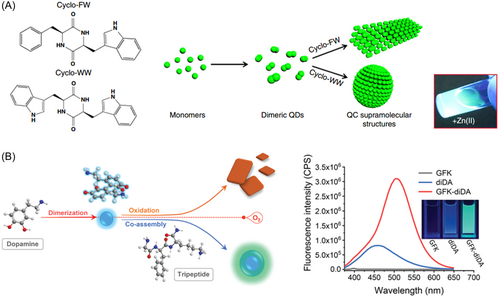
4 LIFE REACTIONS UNDER VBRATIONAL RESONANCE
Resonant coupling is the phenomenon where two or more oscillating systems are synchronized due to their resonant frequencies being aligned or close to each other. Vibrational strong coupling (VSC) is a phenomenon that occurs when vibrational modes of matter strongly interact with modes of electromagnetic wave (light) in a resonant manner. Under this coupling, the vibrational modes of matter intertwine with the photon characteristics, creating a hybrid state known as a polariton, which simultaneously exhibits both the vibrational modes of matter and the photon characteristics of light. VSC has been demonstrated in various experimental systems such as microcavities, plasma nanostructures, and other photonic platforms. By harnessing VSC, we can precisely manipulate and control the interaction between light and matter at the quantum level.
Fabry–Pérot (FP) cavities are often employed to achieve VSC effects. When light enters the FP cavity, it is reflected back and forth between two mirrors, leading to enhanced or suppressed transmission at specific wavelengths, producing a series of resonant modes. VSC can be readily achieved by adjusting the distance of cavity, achieving the regulation of matter interactions. In addition, the modified energy level of molecular vibrations reversely influences the efficiency of chemical reactions as well. For example, Gao et al.30 reported that the hydrolysis of ATP was enhanced about 10-fold through the VSC between O-H vibration and FP cavity modes (Figure 2A). Gu et al.31 chose the isothermal replication of DNA as an in vitro typical model of biochemical reactions and the results showed that OH-based VSC significantly inhibited the efficiency of recombinase polymerase amplification (RPA) by up to ∼58% (Figure 2B). Zhong et al.27 found that VSC can significantly reduce the melting temperature (Tm) of double stranded DNA (dsDNA), which was accurately reflected by DNA origami (Figure 2C,D). These studies reveal that quantum phenomena in biosystems already exhibits the potential to spawn innovative technologies for life regulation.
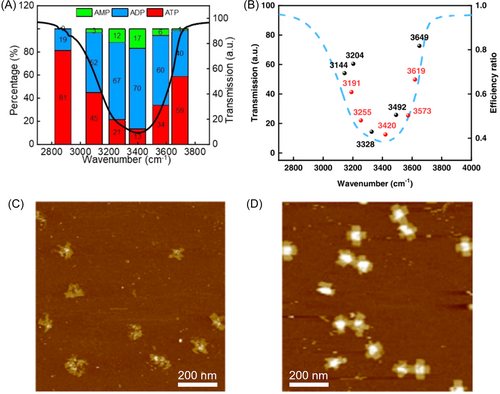
Similarly, when the laser energy is resonantly absorbed by molecular vibrations, it also can light up reactions and achieve the precise modulation of reactions.28, 29 Recently, Zhang et al.32 studied the quantum effect of mid-infrared stimulation (MIRS, wavelength 5.6 μm) on DNA replication (Figure 3A).32 It was found that the resonant absorption of MIR photons by carboxylic acid groups can significantly promote the unwinding of dsDNA and improve the efficiency of polymerase chain reaction (PCR) (Figure 3B,C). Li et al.33 also found that the carboxylic acid group of deoxyribonucleotides can resonantly absorb 53 THz MIR and the THz stimulation favors prolonged amplification reactions without loss of enzyme fidelity (Figure 3D).33 This THz-PCR technique further demonstrated the nonthermal quantum effects due to vibrational resonant absorption.
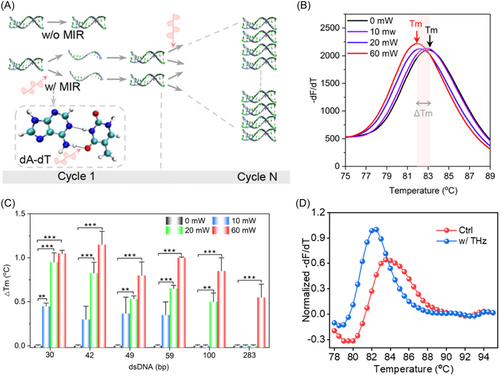
5 SPATIOTEMPORAL OMICS OF MEDICINE FREQUENCY
In frequency medicine, lasers are used to reestablish the communication between cells in an organism by delivering photons of a specific frequency, thereby awakening the activity of nonfunctioning cells. The potential of frequency medicine has been proven in the treatment of oncological and neurological diseases as well as in the field of medical aesthetics. For example, Liu et al.34 found that laser (wavelength 5.6 μm) can modulate K+ channel activity, neuronal signaling, and sensorimotor behavior in a nonthermal manner by inducing C=O bond resonance.34 It was found that the resonant absorption of MIR photons by carboxylic acid groups can promote the unwinding of dsDNA and improve the efficiency of PCR.32, 33 Recent research results from our group also showed that the proliferation and migration of fibroblasts were significantly increased after 1-min 5.6-μm MIRS.35 In addition, researchers found that laser with specific frequency had a significant effect on repairing the reduced frequency of action potentials in nerve cells due to insufficient ATP supply.36 This phenomenon suggests that frequency medicine focuses not only on biochemical changes within the cell, but also on the electrical activities of the cell, which demonstrates the complexity of the therapeutic mechanisms from both spatial and temporal perspectives.
Although lasers have been used to treat a wide variety of diseases, however, as an emerging therapeutic approach, their therapeutic efficacy is still somewhat controversial, mainly because of the following two reasons: first, the potential biochemical mechanisms are still poorly understood, and therefore their current applications is mainly based on empiricism; second, a large number of parameters need to be selected and specified for each treatment, inappropriate choice of parameters may lead to a decrease in the therapeutic efficacy or even undesirable therapeutic outcomes. Laser treatments at different frequencies may trigger a number of different changes in cells, cytokines or signaling pathways, so the appropriate combination of laser frequencies needs to be specified. At the same time, the optimal treatment time of lasers with different frequencies may be different, and it is necessary to realize the precise spatiotemporal combination of laser frequencies to form different energy groups, so as to play a highly efficient and precise energy injection and regulation for the disease, and to greatly improve the effectiveness and high efficiency of frequency-based therapies. Frequency medicine involves complex interactions of spatiotemporal combinations and covers the association between frequency-specific lasers and various molecules, cells and electrical activities in living organisms. An in-depth study of these interactions will provide a deeper understanding of future therapeutic approaches, as well as open up new perspectives for clinical practice and medical research (Figure 4).
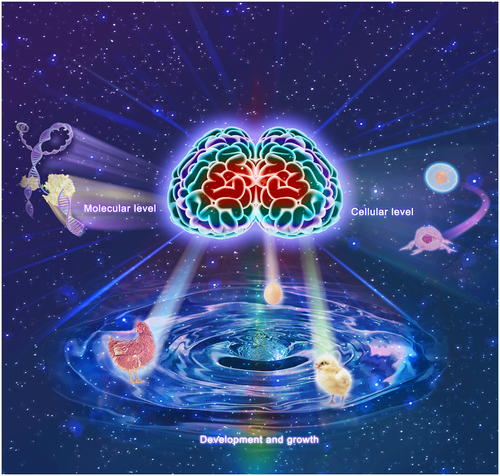
From the perspective of quantum mechanics and the scientist David Bohm's precise explanation of Einstein's mass-energy equivalence E = mc2, we know that matter is essentially a collection of light and energy. Viruses, bacteria, etc. look like matter under the microscope, but are also essentially combinations of energy of different frequencies (E = hν). In this sense, diseases could be just some disturbance of normal vibrations of human frequencies, which somehow relates to the traditional Chinese medicine. Different diseases correspond to different vibrational frequencies and could be eliminated correctly by the VSC mechanism. Similarly, genomics establishes genetic spectrum through genetic analysis of large sample populations to achieve personalized and precise treatment. Should we obtain the spatiotemporal omics of disease related frequencies, identified energy can be delivered to cells through precise spatiotemporal combinations, it can greatly improve the curing effects of diseases and achieve precise and efficient treatment.
Chinese medicine, being considered as the medicine of energy, seems very close to the medicine of frequencies, mainly utilizes herbs to adjust and replenish human's dysfunctional energy system. From an energetic perspective, herbal formulas could be understood as combinations of frequencies or energies. This combination is capable of realizing the conversion of matter and energy, adjusting the vibrational frequencies of diseases, and achieving the purpose of curing diseases. The broad-spectrum laser-based therapies commonly used at present is tantamount to treat with a mixture of all herbs, which may have some therapeutic effect to a certain extent, but cannot avoid negative consequences. This is also the reason why current IR-based therapies have negative outcomes. Everything on earth vibrates and each substance vibrate with unique frequency. Establishing the spatiotemporal omics of vibrational frequencies (for short, vibratomics) of life, and integrating matter, energy, and information into a single entity through spatiotemporal combining precise frequencies, could be an effective way to truly extract the essence and achieve precise and efficient treatment.
6 CONCLUSION AND OUTLOOK
In conclusion, the vibrational frequencies generated by molecules, including biomaterials, are crucial for the efficient resonance energy coupling and transmission in living organisms. This implies that frequency medicine could influence interactions and reactions within the organism through regulating molecular vibrations within biomaterials. Although the tools e.g., VSC in frequency medicine cannot directly break or form covalent bonds, they hold the potential to indirectly impact physiological processes by adjusting the vibrational states of molecules in biomaterials. Therefore, understanding and harnessing these vibrational frequencies could provide a theoretical foundation for the development of novel frequency medicine approaches and offer new perspectives for interdisciplinary research in biomaterials science and medicine. The special properties of water, e.g., the ultrahigh molar concentration, the hydrogen bond network and their vibrational energy levels close to other biochemical groups’, not only allow themselves to build a resonant energy network for both VSC and information transmission, but also coordinate and unify all the interactions and reactions within cells similar to the conductor of symphony orchestra. Hence, the spatiotemporal combination of vibrational frequencies can significantly influence the energy atlas of life, which could deepen the understanding of traditional Chinese medicine since it has been considered as medicine of energy. We envision that vibratomics holds great promise to realize medicine of frequencies, and opens up a new world for the next generation pharmaceutics, e.g., terahertz drugs.
AUTHOR CONTRIBUTIONS
Li-Ping Wang: Writing—original draft (equal); writing—review and editing; investigation (equal). Feng Gao: Writing—original draft (equal) writing—review and editing (equal); visualization (equal). Zhou-Xiang Zhao: Writing—original draft (equal); writing—review and editing (equal); resources (equal). Shi-Hao Liu: Review and editing (equal), visualization (equal). Ruisong Xu: Writing—review and editing (equal); resources (equal). Jun Guo: Writing—review and editing (equal); resources (equal); visualization (equal). Feng Zhang: Conceptualization (lead); funding acquisition (lead), project administration (lead); writing—review and editing (equal). All authors have read and approved the final manuscript.
ACKNOWLEDGMENTS
We sincerely appreciate professor Hu Jun for providing us with highly valuable suggestions. We are grateful to the National Natural Science Foundation of China (No. T2241002, 32271298), the opening grants of Innovation Laboratory of Terahertz Biophysics (No. 23-163-00-GZ-001-001-02-01), the National Key Research and Development Program of China (No. 2021YFA1200402), and Wenzhou Institute of the University of Chinese Academy of Sciences (WIUCASQD2021003) for support.
CONFLICT OF INTEREST STATEMENT
The authors declare no conflict of interest.
ETHICS STATEMENT
The authors have nothing to report.
Open Research
DATA AVAILABILITY STATEMENT
The authors have nothing to report.



